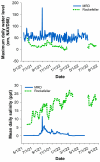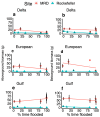Salt Water Exposure Exacerbates the Negative Response of Phragmites australis Haplotypes to Sea-Level Rise
- PMID: 38592938
- PMCID: PMC10974843
- DOI: 10.3390/plants13060906
Salt Water Exposure Exacerbates the Negative Response of Phragmites australis Haplotypes to Sea-Level Rise
Abstract
The response of coastal wetlands to sea-level rise (SLR) largely depends on the tolerance of individual plant species to inundation stress and, in brackish and freshwater wetlands, exposure to higher salinities. Phragmites australis is a cosmopolitan wetland reed that grows in saline to freshwater marshes. P. australis has many genetically distinct haplotypes, some of which are invasive and the focus of considerable research and management. However, the relative response of P. australis haplotypes to SLR is not well known, despite the importance of predicting future distribution changes and understanding its role in marsh response and resilience to SLR. Here, we use a marsh organ experiment to test how factors associated with sea level rise-inundation and seawater exposure-affect the porewater chemistry and growth response of three P. australis haplotypes along the northern Gulf of Mexico coast. We planted three P. australis lineages (Delta, European, and Gulf) into marsh organs at five different elevations in channels at two locations, representing a low (Mississippi River Birdsfoot delta; 0-13 ppt) and high exposure to salinity (Mermentau basin; 6-18 ppt) for two growing seasons. Haplotypes responded differently to flooding and site conditions; the Delta haplotype was more resilient to high salinity, while the Gulf type was less susceptible to flood stress in the freshwater site. Survivorship across haplotypes after two growing seasons was 42% lower at the brackish site than at the freshwater site, associated with high salinity and sulfide concentrations. Flooding greater than 19% of the time led to lower survival across both sites linked to high concentrations of acetic acid in the porewater. Increased flood duration was negatively correlated with live aboveground biomass in the high-salinity site (χ2 = 10.37, p = 0.001), while no such relationship was detected in the low-salinity site, indicating that flood tolerance is greater under freshwater conditions. These results show that the vulnerability of all haplotypes of P. australis to rising sea levels depends on exposure to saline water and that a combination of flooding and salinity may help control invasive haplotypes.
Keywords: dieback; ecosystem services; habitat loss; invasion; restoration; sea-level rise; stress; wetlands.
Conflict of interest statement
The authors declare no conflicts of interest.
Figures








Similar articles
-
Co-evolution of wetland landscapes, flooding, and human settlement in the Mississippi River Delta Plain.Sustain Sci. 2016;11(4):711-731. doi: 10.1007/s11625-016-0374-4. Epub 2016 May 26. Sustain Sci. 2016. PMID: 30174740 Free PMC article.
-
Modeling net ecosystem carbon balance and loss in coastal wetlands exposed to sea-level rise and saltwater intrusion.Ecol Appl. 2022 Dec;32(8):e2702. doi: 10.1002/eap.2702. Epub 2022 Aug 12. Ecol Appl. 2022. PMID: 35751522 Free PMC article.
-
Salinity pulses interact with seasonal dry-down to increase ecosystem carbon loss in marshes of the Florida Everglades.Ecol Appl. 2018 Dec;28(8):2092-2108. doi: 10.1002/eap.1798. Epub 2018 Oct 30. Ecol Appl. 2018. PMID: 30376192
-
Salinity tolerances and use of saline environments by freshwater turtles: implications of sea level rise.Biol Rev Camb Philos Soc. 2018 Aug;93(3):1634-1648. doi: 10.1111/brv.12410. Epub 2018 Mar 25. Biol Rev Camb Philos Soc. 2018. PMID: 29575680 Review.
-
Coastal freshwater wetlands squeezed between migrating salt marshes and working lands.Sci Adv. 2022 Jul;8(26):eadd1628. doi: 10.1126/sciadv.add1628. Epub 2022 Jun 29. Sci Adv. 2022. PMID: 35767608 Free PMC article. Review.
References
-
- Jump A.S., Ruiz-Benito P., Greenwood S., Allen C.D., Kitzberger T., Fensham R., Martínez-Vilalta J., Lloret F. Structural Overshoot of Tree Growth with Climate Variability and the Global Spectrum of Drought-Induced Forest Dieback. Glob. Change Biol. 2017;23:3742–3757. doi: 10.1111/gcb.13636. - DOI - PubMed
-
- McKee K.L., Mendelssohn I.A., Materne M.D. Acute Salt Marsh Dieback in the Mississippi River Deltaic Plain: A Drought-Induced Phenomenon? Glob. Ecol. Biogeogr. 2004;13:65–73. doi: 10.1111/j.1466-882X.2004.00075.x. - DOI
-
- Strzepek K., Yohe G., Neumann J., Boehlert B. Characterizing Changes in Drought Risk for the United States from Climate Change. Environ. Res. Lett. 2010;5:3742–3757. doi: 10.1088/1748-9326/5/4/044012. - DOI
-
- Mitsch W.J., Hernandez M.E. Landscape and Climate Change Threats to Wetlands of North and Central America. Aquat. Sci. 2013;75:133–149. doi: 10.1007/s00027-012-0262-7. - DOI
Grants and funding
LinkOut - more resources
Full Text Sources

